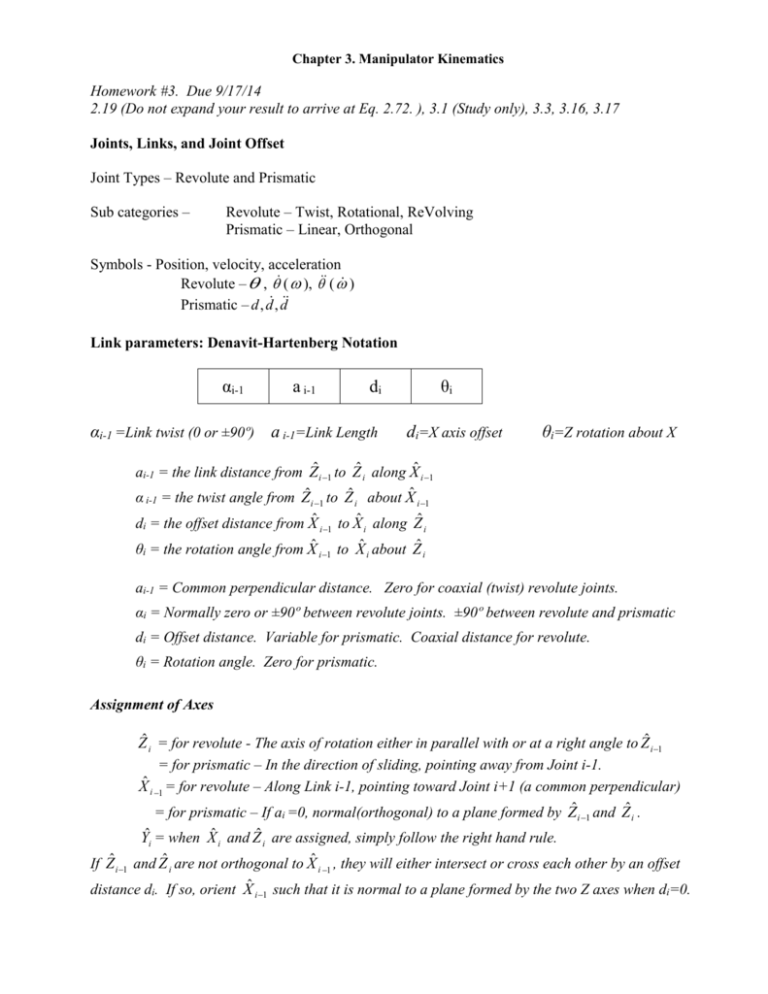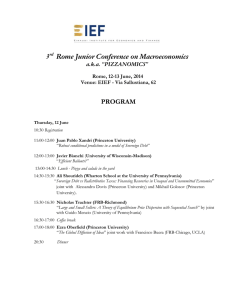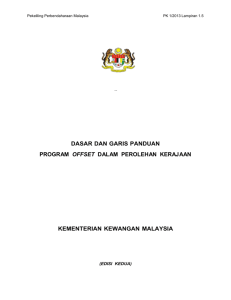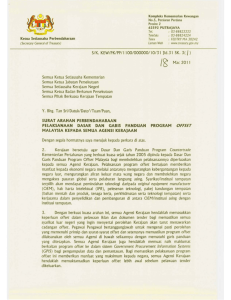Chapter 3 Updated 9-15
advertisement

Chapter 3. Manipulator Kinematics
Homework #3. Due 9/17/14
2.19 (Do not expand your result to arrive at Eq. 2.72. ), 3.1 (Study only), 3.3, 3.16, 3.17
Joints, Links, and Joint Offset
Joint Types – Revolute and Prismatic
Sub categories –
Revolute – Twist, Rotational, ReVolving
Prismatic – Linear, Orthogonal
Symbols - Position, velocity, acceleration
Revolute – , ( ), ( )
Prismatic – d , d , d
Link parameters: Denavit-Hartenberg Notation
αi-1
a i-1
di
αi-1 =Link twist (0 or ±90º) a i-1=Link Length
θi
di=X axis offset
θi=Z rotation about X
ai-1 = the link distance from Zˆi 1 to Ẑ i along Xˆ i 1
α i-1 = the twist angle from Zˆ to Ẑ about Xˆ
i 1
i
i 1
di = the offset distance from Xˆ i 1 to X̂ i along Ẑ i
θi = the rotation angle from Xˆ i 1 to X̂ i about Ẑ i
ai-1 = Common perpendicular distance. Zero for coaxial (twist) revolute joints.
αi = Normally zero or ±90º between revolute joints. ±90º between revolute and prismatic
di = Offset distance. Variable for prismatic. Coaxial distance for revolute.
θi = Rotation angle. Zero for prismatic.
Assignment of Axes
Ẑ i = for revolute - The axis of rotation either in parallel with or at a right angle to Zˆ i 1
= for prismatic – In the direction of sliding, pointing away from Joint i-1.
ˆ
X i 1 = for revolute – Along Link i-1, pointing toward Joint i+1 (a common perpendicular)
= for prismatic – If ai =0, normal(orthogonal) to a plane formed by Zˆ and Ẑ .
i 1
If Zˆ i 1
i
Yˆi = when X̂ i and Ẑ i are assigned, simply follow the right hand rule.
and Ẑ are not orthogonal to Xˆ , they will either intersect or cross each other by an offset
i
i 1
distance di. If so, orient Xˆ i 1 such that it is normal to a plane formed by the two Z axes when di=0.
Rules: Ẑ i is formed by rotating Zˆ i 1 about Xˆ i 1 .
If Zˆ and Ẑ do not intersect,
i 1
i
ai (“the Z distance”) is the perpendicular distance between Zˆ i 1 and Ẑ i .
di (“the X distance”) is the perpendicular distance between Xˆ and X̂ .
i 1
i
If Zˆ i 1 and Ẑ i intersect,
ai=0
di is the perpendicular distance between Xˆ i 1 and Ẑ i .
Link Transformation
si
0
a i 1
ci
s c
ci c i 1 s i 1 s i 1d i
i
i 1
i 1
iT
si s i 1 ci s i 1 c i 1
c i 1di
0
0
0
0
ci
s
i 1
i
T
i
0
0
c i
0
i 1
iT
s i
0
si
ci
0
0
0 a i 1
0 0
when i 1 =0
1 di
0 0
s i
0
c i
0
0 a i 1
1 d i
when i 1 =90.
0
0
0
0
c123 s123
s
0
123 c123
T
3
0
0
0
0
c1 s1
s
0
1 c1
1T
0
0
0
0
0 a1
0 0
1 d1
0 0
(3.6)
c12
s
0
12
2T
0
0
0 a1c1a2 c12a3
0
s1a2 s12a3
1
d1 d 2 d3
0
0
s12 0 a1c1a2
c12 0
s1a2
0
1 d1 d 2
0
0
0
Reference Frames
Base{B}, Station{S}, Wrist{W}, Tool{T}, Universal{U} or Global{G}
Use the relationship ABT BAT T BAT 1 , CAT ABT CBT , and ( ABT CBT ) 1 CB T 1 ABT 1 to define a position vector
with respect to any frame in the chain of frames.
Link Length (αi-1) or Link Offset (di)? – A Simple Test
1)
Starting from the base, successively label straight fixed length link segments by L1, L2, …, .
Do the same for variable length segments by D1, D2, …
2) If Li (or Di) coincides or is parallel to the axis of rotation or translation of the predecessor
joint, Li (or Di) is a link offset (di). If it is orthogonal (or radial), it is a link length (αi-1).
Between Joint Frame Combinations
There are total 16 combinations possible as summarized in the table below. If Zˆ i 1 and Ẑ i are
parallel, Xˆ connects the two axes if the offset di is zero. If Zˆ and Ẑ are not parallel (orthogonal
i 1
i 1
i
without the effect of the offset), Xˆ i 1 provides the rotation axis for Zˆ i 1 to transform into Ẑ i . You can
imitate the two frame set up with your two hands using two thumbs (Z) and two index fingers (X).
The right hand rule determines Yˆi which is normal to the XZ plane.
Zi, Xi
b
Zi-1, Xi-1
a
Joint i-1
Joint i
Zi-1, Zi
Xi-1, Xi
ai-1
di
R or P
R or P
// or
// or
a or b
a or b
R – Revolute P – Prismatic // - Parallel - Orthogonal
di =dist(Zi-1, Zi), measured along Xi-1
ai-1 = dist(Xi-1Xi), measured along Z
Six Axes Robot
Z6
X6
L8
X5
i
αi-1
a i-1
di
θi
1
0
0
L1
θ1
2
-90º
L3
L2
θ2
3
180º
L4
0
θ3
4
-90º
L6
L5
θ4
5
90º
0
L7
θ5
6
-90º
L8
0
θ6
L2
L2
LL2
Z4
2
Z5
X4
LL2
2
LL7
L2
2
L2
LL2
LL2
X3
2
L6
2
L5
Z3
X2
Z2
LL2
LL2
2
2
L4
L2
4
L2
L2
L2
LL2
2
L2
LL3
2
L2
L2
L2
L2L
L2
2
L2
L2
LL 2
2
L1
L2
ZZ11
X1
L2
LL1
L22
LL2
2
L2
L2
L2
Z2
X3
X3
SCARA Robot
X3
X2
Z3
LL55
L3
L4
L2
d3
Z1
X1
X4
i
αi-1
a i-1
di
θi
1
0
0
L1
θ1
2
0
L3
L2+L4
θ2
3
180º
L5
d3
0
4
0
0
0
θ4
X1
Z4
L1
X0
Cartesian Robot
X2
X2
D2
Z1
X1
Z1
Z2
D2
L3
L2
L2
X1
L2
L2
L1
L2
D1
L1
L2
L2
L1 LL
1
L1 L1
L1
Z0
L2
2
D3
X3
Z3
i
αi-1
a i-1
di
θi
1
0
0
d1
0
2
90º
L1
d2
0
3
90º
L2
d3
0
4
0
0
0
θ4
Z4
Wrist Joint Equivalence – Yaw-Pitch-Roll - Euler Z-Y-Z rotation
Three Way Socket Joint
(ZYZ Rotation on Moving Frame)
Link
Offset
Link
Length
PUMA 560 Joint Configuration
X5
Z5
Joints 4-6
d4
L6
L5
L8
L7
a3
X6
X4
X3
Z6
Z4
Z3
Z2
X3
L3
L2
X2
a2
Z1
Z3
L4
d3
a
Joints 1-3
3
Z3
X3
X1
L1
d3=L2-L4
d4=L6+L7
a2=L3
a3=L5
i
αi-1
a i-1
di
θi
i
αi-1
a i-1
di
θi
1
0
0
0
θ1
1
0
0
0
θ1
2
-90º
0
L1
θ2
2
-90º
0
0
θ2
3
0
L3
L2-L4
θ3
3
0
α2
d3
θ3
4
-90º
L5
L6
θ4
4
-90º
α3
d4
θ4
5
90º
0
L7
θ5
5
90º
0
0
θ5
6
-90º
0
L8
θ6
6
-90º
0
0
θ6


